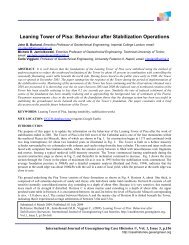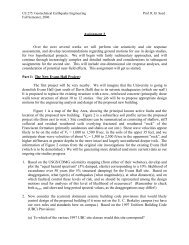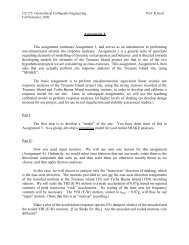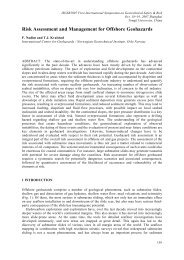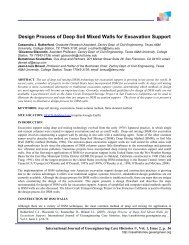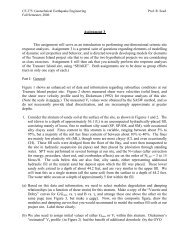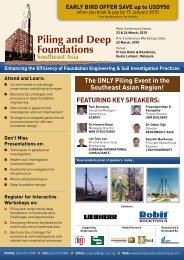Reliability Evaluation of Bored Piles with Multiple Defects - GEOSNet
Reliability Evaluation of Bored Piles with Multiple Defects - GEOSNet
Reliability Evaluation of Bored Piles with Multiple Defects - GEOSNet
Create successful ePaper yourself
Turn your PDF publications into a flip-book with our unique Google optimized e-Paper software.
ISGSR2007 First International Symposium on Geotechnical Safety & Risk<br />
Oct. 18~19, 2007 Shanghai<br />
Tongji University, China<br />
<strong>Reliability</strong> evaluation <strong>of</strong> bored piles <strong>with</strong> multiple defects<br />
D. Q. Li<br />
State Key Laboratory <strong>of</strong> Water Resources and Hydropower Engineering Science,<br />
Wuhan University, Wuhan, China<br />
ABSTRACT:This paper aims to propose a methodology to quantitatively evaluate the reliability <strong>of</strong><br />
pile foundations considering the possibility <strong>of</strong> multiple pile defects presence. The probability <strong>of</strong> failure<br />
<strong>of</strong> the pile considering the possibility <strong>of</strong> multiple defects presence is formulated by integrating the<br />
probabilities <strong>of</strong> failure for an intact pile and a pile <strong>with</strong> multiple defects systematically using the total<br />
probability theory. A pile capacity reduction factor is presented to account for the effect <strong>of</strong> the<br />
considered pile defects on the pile capacity. Formulae for calculating the coefficient <strong>of</strong> variation <strong>of</strong> the<br />
pile <strong>with</strong> defects are formulated. The reliability analysis is carried out in the framework <strong>of</strong> load and<br />
resistance factor design. An example is investigated to illustrate the proposed method. The results<br />
indicate that the impact <strong>of</strong> the possibility <strong>of</strong> multiple defects presence on the reliability <strong>of</strong> piles can be<br />
quantitatively evaluated using the proposed method in a rational way. The reliability <strong>of</strong> a pile is<br />
adversely affected by the presence <strong>of</strong> pile defects. The reliability <strong>of</strong> the pile will be overestimated if<br />
the possibility <strong>of</strong> multiple pile defects presence is not taken into account. If the correlation between<br />
two types <strong>of</strong> defects is not considered, the reliability <strong>of</strong> the pile will also be overestimated.<br />
1 INTRODUCTION<br />
Large-diameter bored piles are commonly used to support heavy structures such as high-rise buildings<br />
and bridges. From time to time, however, due to some factors that can influence the quality <strong>of</strong> piling<br />
on a particular site, such as the variability <strong>of</strong> ground conditions across the site and <strong>with</strong> depth,<br />
knowledge <strong>of</strong> the specific ground conditions gained from a detailed site investigation, contractor skill<br />
and experience <strong>with</strong> a given pile type under similar operating conditions, supply <strong>of</strong> materials <strong>of</strong> correct<br />
quality, appropriateness <strong>of</strong> construction procedures for the particular soil and groundwater conditions,<br />
and other factors (Cameron and Chapman 2004), minor or major defects may be introduced during or<br />
after pile construction. Some examples <strong>of</strong> defects are voids, soil inclusions, honeycombing, cracks,<br />
necking, and rebar corrosion (Fleming et al. 1992). To ensure the safety <strong>of</strong> pile foundations and to<br />
avoid the use <strong>of</strong> excessively conservative designs, some nondestructive evaluation (NDE) tests are<br />
<strong>of</strong>ten conducted after pile construction, such as cross-hole sonic logging (CSL), sonic echo testing,<br />
impedance logging, and impulse response testing.<br />
<strong>Defects</strong> that are present <strong>with</strong>in a pile are not detected completely by the current NDE methods<br />
and therefore some defects may remain <strong>with</strong>in the pile foundation throughout its service life<br />
(Finno and Gassman 1998; Iskander et al. 2003). Several experimental studies (Baker et al. 1993;<br />
Hassan and O’Neill 1998; Chernauskas and Paikowsky 1999; Iskander et al. 2003) have addressed<br />
the ability <strong>of</strong> CSL to detect defects in piles. Based on these studies and from expert opinion, there<br />
is a lower limit on the size <strong>of</strong> defects that can be detected by CSL. Baker et al. (1993) found that<br />
CSL could only detect defects that occupied about 15% <strong>of</strong> the cross-sectional areas <strong>of</strong> the drilled<br />
shafts. O’Neil and Sarhan (2004) found that rebar corrosion is typically undetectable <strong>with</strong><br />
conventional NDE tests and its effect is becomes severe many years after the installation <strong>of</strong> a<br />
drilled shaft. These defects can lead to unsatisfactory performance <strong>of</strong> pile foundations,<br />
particularly when a pile is subject to bending, or delays in construction (O’Neil et al. 2003;<br />
Sarhan et al. 2002, 2004; Poulos 2005), which may further impact the reliability <strong>of</strong> pile<br />
foundations. Therefore, it is necessary to investigate the reliability <strong>of</strong> pile foundations considering<br />
the possibility <strong>of</strong> defects presence. Zhang et al. (2006) studied the reliability <strong>of</strong> single bored piles<br />
455
<strong>with</strong> toe debris. However, the reliability <strong>of</strong> bored piles <strong>with</strong> multiple defects is not sufficiently<br />
investigated.<br />
The objective <strong>of</strong> this paper is to propose a methodology to quantitatively evaluate the reliability<br />
<strong>of</strong> pile foundations considering the possibility <strong>of</strong> multiple pile defects presence. For illustrative<br />
purposes, this paper will focus on voids and rebar corrosion. Discussions on other defects, such as<br />
cracks, soil inclusions, and toe debris are beyond the scope <strong>of</strong> the paper. The probability <strong>of</strong><br />
failure <strong>of</strong> the pile is formulated <strong>with</strong> a consideration <strong>of</strong> the possibility <strong>of</strong> multiple defects presence.<br />
A pile capacity reduction factor is presented to take into account the effect <strong>of</strong> pile defects on the<br />
pile capacity. Formulae for calculating the coefficient <strong>of</strong> variation <strong>of</strong> the pile capacity <strong>with</strong> defects<br />
are formulated. An example is presented to illustrate the proposed method.<br />
2 RELIABILITY OF PILES WITH MULTIPLE DEFECTS<br />
Consider the case <strong>of</strong> single bored piles <strong>with</strong> two types <strong>of</strong> defects, namely voids and rebar<br />
corrosion, along <strong>with</strong> other types <strong>of</strong> imperfections such as cracks, necking, and toe debris. The<br />
pile performance is still uncertain even when the pile is free from the considered two types <strong>of</strong><br />
defects due to the presence <strong>of</strong> other types <strong>of</strong> imperfections as well as many other sources <strong>of</strong><br />
uncertainty such as spatial variability <strong>of</strong> soils, various construction effects, and load effects. Since<br />
the effects <strong>of</strong> the defects could be correlated, the probability <strong>of</strong> failure <strong>of</strong> the pile due to the<br />
concurrent presence <strong>of</strong> those types <strong>of</strong> defects may not be the sum <strong>of</strong> the probability <strong>of</strong> failure due<br />
to individual types <strong>of</strong> defects. Based on the total probability theorem (e.g., Ang and Tang 2006),<br />
the probability <strong>of</strong> unsatisfactory performance <strong>of</strong> the pile <strong>with</strong> two types <strong>of</strong> defects, p f , can be<br />
calculated as follows:<br />
p = PF ( | E)(1 − p− p− p ) + PF ( | E) p+ PF ( | E) p+ PF ( | E ) p (1)<br />
f<br />
1 2 12 1 1 2 2 12 12<br />
where p 1 , p 2 and p 12 = occurrence probabilities <strong>of</strong> the first type <strong>of</strong> defect alone, the second type <strong>of</strong><br />
defect alone, and the concurrent occurrence <strong>of</strong> both types <strong>of</strong> defects, respectively; F = event <strong>of</strong> pile<br />
failure; E 1 , E 2 , E 12 and Ē = events <strong>of</strong> the first type <strong>of</strong> defect alone, the second type <strong>of</strong> defect alone, the<br />
concurrent presence <strong>of</strong> both types <strong>of</strong> defects, and the first or the second type <strong>of</strong> defect absence,<br />
respectively; P(F|Ē) and P(F|E i , i = 1, 2, 12) = conditional probabilities <strong>of</strong> unsatisfactory performance<br />
<strong>of</strong> the pile given the absence and presence <strong>of</strong> defects, respectively.<br />
The evaluation <strong>of</strong> conditional probabilities P(F|Ē) and P(F|E i , i = 1, 2, 12) can be formulated as<br />
follows. The probability <strong>of</strong> failure, p f , can be expressed in terms <strong>of</strong> β as follows:<br />
p = 1 −Φ (β)<br />
(2)<br />
f<br />
Where Φ = standard normal distribution function; β = reliability index. It can be seen that the<br />
probability <strong>of</strong> failure can be calculated based on the calculated β The reliability index <strong>of</strong> a pile<br />
can be calculated using the first-order reliability method. If both resistance and load effects are<br />
lognormal variates, then the reliability index for a linear performance function can be written as<br />
(Withiam et al. 2001)<br />
⎡ Q ⎤<br />
⎢<br />
λ FS( + 1)<br />
⎥ + +<br />
ln( ⎢<br />
)<br />
⎢<br />
⎢<br />
β =<br />
⎣<br />
D<br />
R<br />
2 2<br />
Q 1 COVQD<br />
COV<br />
L<br />
QL<br />
⎥<br />
2<br />
QD<br />
( λ )<br />
1<br />
R<br />
QD<br />
+ λ ⎥ + COV<br />
QL<br />
QL<br />
⎥⎦<br />
2 2 2<br />
ln((1 + COVR )(1 + COVQD + COVQL<br />
))<br />
(3)<br />
where FS = factor <strong>of</strong> safety in the traditional allowable stress design; λ R and COV R = bias factor<br />
and coefficient <strong>of</strong> variation (COV) <strong>of</strong> the pile capacity, respectively; Q D and Q L = nominal values<br />
<strong>of</strong> dead load and live load, respectively; λ QD and λ QL = bias factors for the dead load and live load,<br />
456
espectively; COV QD and COV QL = coefficients <strong>of</strong> variation for the dead load and live load,<br />
respectively; γ D and γ L = load factors for the dead load and live load, respectively.<br />
As can be seen from Eq. (3), only two parameters, λ R and COV R , are associated <strong>with</strong> the pile<br />
capacity. All other parameters are associated <strong>with</strong> the loads. If a pile contains voids or rebar<br />
corrosion, the pile capacity will be adversely affected. In other words, the statistics associated<br />
<strong>with</strong> the pile capacity will be altered. For instance, λ R will be reduced while COV R may be<br />
increased. For simplicity, COV R for a pile <strong>with</strong> voids or rebar corrosion is assumed to be the same<br />
as that for a pile free <strong>of</strong> voids or rebar corrosion. Under this assumption, only λ R for a pile <strong>with</strong><br />
voids or rebar corrosion needs to be determined to calculate the corresponding reliability index<br />
using Eq. (3).<br />
To provide a measure <strong>of</strong> the effect <strong>of</strong> voids or rebar corrosion, following Poulos (1997) and<br />
O’Neill and Sarhan (2004), a pile capacity reduction factor, R F , is used,<br />
R<br />
F<br />
Q<br />
Q<br />
d<br />
= (4)<br />
0<br />
in which Q 0 = failure load <strong>of</strong> a pile <strong>with</strong>out defects and Q d = failure load <strong>of</strong> a pile <strong>with</strong> defects. Strictly<br />
speaking, R F should be treated as a random variable. Due to lack <strong>of</strong> sufficient statistical data for R F , R F<br />
is treated as a deterministic quantity in this study, but its value will depend on the type <strong>of</strong> defect, the<br />
defect size, and the pile specifics. Once R F is obtained, the bias factor <strong>of</strong> the capacity <strong>of</strong> the pile <strong>with</strong><br />
defects, λ RD , is given by<br />
λ<br />
= R λ<br />
(5)<br />
RD F R<br />
Thus, the reliability <strong>of</strong> the defective pile can also be calculated using Eq. (3) by replacing λ R <strong>with</strong> λ RD .<br />
Then, the conditional probability <strong>of</strong> unsatisfactory performance can also be calculated using Eqs. (2)<br />
and (3).<br />
3 IMPACT OF DEFECTS ON PILE CAPACITY<br />
The presence <strong>of</strong> defects does not always impair the ability <strong>of</strong> pile shaft to carry its intended load. If<br />
defects occur <strong>with</strong>in a zone <strong>of</strong> high structural stress <strong>with</strong>in a pile shaft, however, the capacity <strong>of</strong> the<br />
pile will be adversely affected and the structural capacity will need to be reduced for design purposes.<br />
Following Sarhan et al. (2004), such zones are termed critical zone in this paper. For the case <strong>of</strong> bored<br />
piles to resist axial load, the current design practice is to assume that the stress remains constant along<br />
the entire pile shaft. This practice neglects any load transfer through soil-shaft contact, thus resulting<br />
in the critical zone for axial stress being the entire length <strong>of</strong> the shaft. However, the critical zone is the<br />
top 12.1D for flexural or combined loading (Sarhan et al. 2004), where D is pile diameter.<br />
For the purpose <strong>of</strong> illustration, the defects, such as voids and rebar corrosion, are considered to<br />
investigate the impact <strong>of</strong> defects on pile capacity. In the following sections, the void along, the rebar<br />
corrosion alone, and the concurrent presence <strong>of</strong> both types <strong>of</strong> defects are referred as cases 1, 2, and 3,<br />
respectively. The considered void occupies 15% <strong>of</strong> the cross-sectional areas <strong>of</strong> the pile shaft. The<br />
length <strong>of</strong> the void is not a variable and is equal to the pile diameter. The void is entirely located <strong>with</strong>in<br />
the concrete cover (arch length = pile diameter). Fig. 1 shows the parameters that define the geometry<br />
<strong>of</strong> the void defect (Sarhan et al. 2004). The rebar corrosion is simulated by replacing the noncorroded<br />
rebar <strong>with</strong> a smaller diameter rebar, which results in the simulated corroded rebar having a reduced<br />
cross sectional area <strong>of</strong> that <strong>of</strong> the noncorroded rebar. The considered rebar corrosion denotes corrosion<br />
<strong>of</strong> reinforcing encased <strong>with</strong>in the concrete, which results in 22% reduction in total steel area. Note that<br />
when corrosion <strong>of</strong> rebar occurs <strong>with</strong>in a void, namely case 3, the considered rebar corrosion results in<br />
2.5% reduction in total steel area. The steel percentage refers to the percentage <strong>of</strong> total steel lost from<br />
457
all reinforcing bars in case 2 and only from three reinforcing bars in the void in case 3. Based on<br />
studies (Sarhan et al. 2004), for a considered 1.0m diameter bored pile, the pile capacity reduction<br />
factors are 0.89, 0.94, and 0.85 for cases 1, 2, and 3, respectively. It can be seen that the concurrent<br />
presence <strong>of</strong> the void and rebar corrosion has the most adverse impact on the pile capacity. The rebar<br />
corrosion has a slight impact on the pile capacity.<br />
B = D<br />
115°<br />
B = Arch length.<br />
D = Pile diameter.<br />
D 0 = Diameter <strong>of</strong> reinforcement cage.<br />
D0<br />
D<br />
Fig.1 Parameters <strong>of</strong> void (after Sarhan et al. 2004)<br />
4 EXAMPLE<br />
The reliability <strong>of</strong> bored piles considering the possibility <strong>of</strong> void or rebar corrosion presence is<br />
illustrated in this worked example. A similar methodology can be applied to study the reliability<br />
<strong>of</strong> bored piles <strong>with</strong> more than two types <strong>of</strong> defects.<br />
The following load statistics are adopted: λ QD =1.08, λ QL =1.15, γ D =1.25, γ L =1.75, COV QD<br />
=0.13, COV QL =0.18 and Q D /Q L =2.0. These statistics were used in developing the LRFD bridge<br />
design specifications (Withiam et al. 2001). A FS = 2.5 is adopted for the analysis herein. McVay<br />
et al. (1998) calibrated the design and construction procedures outlined by McVay et al (1992) for<br />
bored piles founded on rock. When the soil shaft resistance, the rock shaft resistance, and the end<br />
bearing are all considered, the bias factor and COV <strong>of</strong> the pile capacity are λ R = 1.15 and COV R =<br />
0.17. The test piles in the calibration exercise are assumed to have been constructed properly. If a<br />
void or a rebar corrosion exists, then λ R will decrease due to the reduction in the pile capacity.<br />
Based on the data acquisition (O’Neill and Sarhan 2004), the occurrence probability <strong>of</strong> the<br />
considered void is 0.40 for the case <strong>of</strong> pure axial loading, which consists <strong>of</strong> 0.16 for the void along<br />
presence and 0.24 for the concurrent presence <strong>of</strong> the void and the rebar corrosion. Since the data for<br />
occurrence probability <strong>of</strong> rebar corrosion are not available at this time, following O’Neill and<br />
Sarhan (2004), it is assumed that the occurrence probability <strong>of</strong> the rebar corrosion is 0.05 for the<br />
case <strong>of</strong> pure axial loading. The most likely position for the rebar corrosion will be close to the<br />
ground surface so that it is always located <strong>with</strong>in the critical zone.<br />
After obtaining the reduction factor, the resulting bias factor RD for a pile <strong>with</strong> void or rebar<br />
corrosion can be calculated using Eq. (5), which are 1.02, 1.08, and 0.89 for cases 1, 2, and 3,<br />
respectively. Accordingly, the reliability index and the corresponding probability <strong>of</strong> failure <strong>of</strong> the<br />
defective pile can be calculated using Eqs. (3) and (2), respectively, which are 3.07, 3.27, and 2.91 for<br />
cases 1, 2, and 3, respectively. The corresponding probabilities <strong>of</strong> failure are 1.05×10 -3 , 5.33×10 -4 , and<br />
1.82×10 -3 for cases 1, 2, and 3, respectively. The reliability index for an intact pile <strong>with</strong>out voids or<br />
rebar corrosion, 3.50, and the corresponding probability <strong>of</strong> failure, P(F|Ē) = 2.33×10 -4 , account for<br />
other types <strong>of</strong> imperfections besides voids and rebar corrosion as well as many other sources <strong>of</strong><br />
uncertainty. The reliability index <strong>of</strong> the pile <strong>with</strong> the void and rebar corrosion, 2.91, is significantly<br />
458
smaller than 3.50 for the intact pile <strong>with</strong>out voids or rebar corrosion, which indicates that the<br />
performance <strong>of</strong> the pile is adversely affected due to the concurrent presence <strong>of</strong> void and rebar<br />
corrosion.<br />
Having determined the occurrence probabilities <strong>of</strong> defects and the conditional probabilities <strong>of</strong><br />
unsatisfactory performance <strong>of</strong> the pile given the absence and presence <strong>of</strong> defects, the probability <strong>of</strong><br />
unsatisfactory performance <strong>of</strong> the pile can be calculated using Eq. (1). The corresponding probability<br />
<strong>of</strong> failure <strong>of</strong> the pile is 7.60×10 -4 , which is higher than 2.33×10 -4 for the intact pile <strong>with</strong>out voids or<br />
rebar corrosion. This indicates that when the possibility <strong>of</strong> multiple pile defects presence is not taken<br />
into account, the reliability <strong>of</strong> the pile is overestimated. In addition, if the effect <strong>of</strong> concurrent<br />
occurrence <strong>of</strong> void and rebar corrosion is not taken into account, namely p 12 = 0 in Eq. (1), the<br />
probability <strong>of</strong> failure becomes 3.23×10 -4 . Compared <strong>with</strong> the case that the correlation between void<br />
and rebar corrosion is considered, the reliability <strong>of</strong> the pile is overestimated.<br />
5 CONCLUSIONS<br />
This paper has developed a methodology to evaluate the reliability <strong>of</strong> bored piles <strong>with</strong> a consideration<br />
<strong>of</strong> possibility <strong>of</strong> multiple defects presence. Results from the example indicate that the impact <strong>of</strong> the<br />
possibility <strong>of</strong> multiple defects presence on the reliability <strong>of</strong> piles can be quantitatively evaluated using<br />
the proposed method in a rational way. The reliability <strong>of</strong> the pile is adversely affected due to the<br />
concurrent presence <strong>of</strong> void and rebar corrosion in the example. For instance, the reliability index <strong>of</strong><br />
the pile <strong>with</strong> the void and rebar corrosion, 2.91, is significantly smaller than 3.50 for the intact pile<br />
<strong>with</strong>out voids or rebar corrosion. If the possibility <strong>of</strong> multiple pile defects presence is not taken into<br />
account, the reliability <strong>of</strong> the pile will be overestimated. In addition, if the correlation between void<br />
and rebar corrosion is not considered, the reliability <strong>of</strong> the pile will also be overestimated.<br />
ACKNOWLEDGMENT<br />
This research was substantially supported by National Key Project <strong>of</strong> Scientific and Technical<br />
Supporting Programs Funded by Ministry <strong>of</strong> Science and Technology <strong>of</strong> China (Project NO.<br />
2006BAB04A05).<br />
REFERENCES<br />
Ang, H.-S., and Tang, W. H. (2006). Probability concepts in engineering: emphasis on<br />
applications to civil and environmental engineering, 2nd ed., John Wiley and Sons, New York.<br />
Baker, C. N., Drumright, E. E., Briaud, J. L., Mensah, F. D., and Parikh, G. (1993). Drilled shafts for<br />
bridge foundations. Rep. No. FHWA-RD-92-004, Federal Highway Administration, Washington,<br />
D.C.<br />
Cameron, G., and Chapman, T. (2004). Quality assurance <strong>of</strong> bored pile foundations. Ground<br />
Engineering, 37(2), 35-40.<br />
Chernauskas, L. R., and Paikowsky, S. G. (1999). Deep foundations integrity testing: Techniques<br />
and case histories. Civil Engineering Practice, 14(1), 39-56.<br />
Finno, R. J., and Gassman, S. L. (1998). Impulse response testing <strong>of</strong> drilled shafts. Journal <strong>of</strong><br />
Geotechnical and Geoenvironmental Engineering, 124(10), 965-975.<br />
Fleming. W. G. K., Weltman, A. J., Randolph, M. F., and Elson, W. K. (1992). Piling engineering,<br />
2nd ed., Wiley, New York.<br />
459
Hassan, K. M., O’Neill, M. W. (1998). Structural resistance factors for drilled shafts <strong>with</strong> minor<br />
defects. Final Rep., Phase I, Dept. <strong>of</strong> Civil and Environmental Engineering, Univ. <strong>of</strong> Houston,<br />
Houston.<br />
Iskander, M., Roy, D., Kelley, S., and Ealy, C. (2003). Drilled shaft defects: detection, and effects<br />
on capacity in varved clay. Journal <strong>of</strong> Geotechnical and Geoenvironmental Engineering, 129(12),<br />
1128-1137.<br />
McVay, M. C., Townsend, F. C., and Williams, R. C. (1992). Design <strong>of</strong> socketed drilled shafts in<br />
limestone. Journal <strong>of</strong> Geotechnical Engineering, 118 (10), 1626-1637.<br />
O’Neill, M. W., and Sarhan, H. A. (2004). Structural resistance factors for drilled shafts<br />
considering construction flaws. Current Practices and Future Trends in Deep Foundations,<br />
Geotechnical Special Publication. No. 125, J. A. DiMaggio and M. H. Hussein, eds., ASCE,<br />
Reston, Va., 166-185.<br />
O’Neill, M. W., Tabsh, S. W., and Sarhan, H. A. (2003). Response <strong>of</strong> drilled shafts <strong>with</strong> minor<br />
flaws to axial and lateral loads. Engineering Structures, 25(1), 47-56.<br />
Sarhan, H. A., O’Neill, M. W., and Hassan, K. M. (2002). Flexural performance <strong>of</strong> drilled shafts<br />
<strong>with</strong> minor flaws in stiff clay. Journal <strong>of</strong> Geotechnical and Geoenvironmental Engineering,<br />
128(12), 974-985.<br />
Sarhan, H. A., O’Neill, M. W., and Tabsh, S. W. (2004). Structural capacity reduction for drilled<br />
shafts <strong>with</strong> minor flaws. ACI Structural Journal, 101(3), 291-297.<br />
Poulos, H. G. (1997). Analysis <strong>of</strong> pile groups <strong>with</strong> defect piles. Proceedings <strong>of</strong> the 14th<br />
International Conference on Soil Mechanics and Foundation Engineering, Hamburg, A.A.<br />
Balkema, Rotterdam, 871-876.<br />
Poulos, H. G. (2005). Pile behaviour-consequences <strong>of</strong> geological and construction imperfections.<br />
Journal <strong>of</strong> Geotechnical and Geoenvironmental Engineering, 131(5), 538-563.<br />
Withiam, J. L., Voytko, E. P., Barker, R. M., et al. (2001). Load and resistance factor design<br />
(LRFD) for highway bridge substructures. Report No. FHWA HI-98-032, Federal Highway<br />
Administration, Washington, D. C.<br />
Zhang, L. M., Li, D. Q., and Tang, W. H. (2006). Impact <strong>of</strong> routine quality assurance on<br />
reliability <strong>of</strong> bored piles. Journal <strong>of</strong> Geotechnical and Geoenvironmental Engineering, 132(5),<br />
622-630.<br />
460



